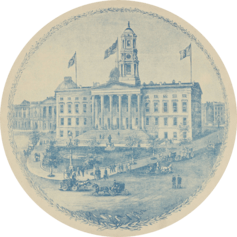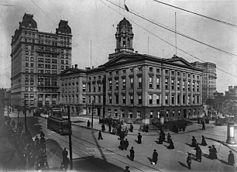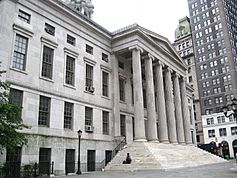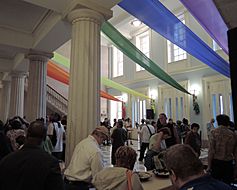Brooklyn Borough Hall facts for kids
|
Brooklyn Borough Hall
|
|
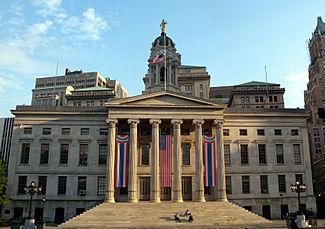
(2009)
|
|
| Location | 209 Joralemon Street Brooklyn, New York 11201 |
|---|---|
| Area | 1 acre (0.40 ha) |
| Built | 1848 |
| Architect | Calvin Pollard Gamaliel King |
| Architectural style | Greek Revival |
| NRHP reference No. | 80002630 |
Quick facts for kids Significant dates |
|
| Added to NRHP | January 10, 1980 |
Brooklyn Borough Hall is an important building in Downtown Brooklyn, New York City. It was designed by architects Calvin Pollard and Gamaliel King. The building was made in the Greek Revival style. This means it looks like ancient Greek temples, with tall columns. It was built using Tuckahoe marble.
The building was finished in 1848. It was first used as the City Hall for the independent City of Brooklyn. In 1898, the City of Brooklyn joined with the larger City of New York. At that time, Kings County became the Borough of Brooklyn. The building then changed its name to Brooklyn Borough Hall.
Contents
History of Brooklyn Borough Hall
Building Brooklyn's City Hall
In 1834, Brooklyn officially became a city. The Remsen and Pierrepont families gave the land for the new city hall. You can still see their names on nearby streets.
The next year, architect Calvin Pollard won a contest to design the building. Construction started in 1836. However, money problems stopped the work for a while.
Work began again in 1845. This time, Gamaliel King was the architect. He had come in second in the first design contest. King was told to make sure his design fit the foundations already built. He kept many ideas from Pollard's original plan. This included the Greek Revival style. The building was completed in 1848.
How the Building Was Used
In 1868, the Kings County Courthouse was built nearby. This made Downtown Brooklyn a busy center for government and business. Later, in the 1940s, new courthouses were built. A plaza was also added in front of Borough Hall. A walkway now connects the building to Cadman Plaza Park.
On February 26, 1895, a fire damaged the building. It destroyed the cupola, which is a small dome on top. A statue of Justice on the cupola was also lost. The top floors were damaged, and water ruined some walls inside.
Three years later, a new cupola was built. It was made of cast-iron in the Victorian style. A flag was placed on top of it. In 1898, Brooklyn became one of the five boroughs of New York City. The building stopped being "City Hall" and became "Borough Hall."
In 1902, a room called the Common Council chamber was changed. It became a new courtroom. This room was designed in the Beaux-Arts style.
For many years, some people wanted to tear down Borough Hall. They thought it was no longer needed. But in 1966, the building was named a city landmark. This helped protect it. On January 10, 1980, it was added to the National Register of Historic Places. This is a list of important places in the country.
In the 1980s, the building had a big makeover. The copper roof on the cupola was fixed. A new statue of Lady Justice was placed on top, replacing the flag. The renovation was finished in 1989.
Gallery
See also
 In Spanish: Brooklyn Borough Hall para niños
In Spanish: Brooklyn Borough Hall para niños


